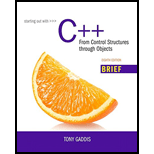
Concept explainers
Rock, Paper, Scissors Game
Write a
1. When the program begins, a random number in the range of 1 through 3 is generated. If the number is 1, then the computer has chosen rock. If the number is 2, then the computer has chosen paper. If the number is 3, then the computer has chosen scissors. (Don’t display the computer’s choice yet.)
2. The user enters his or her choice of “rock”, “paper”, or “scissors” at the keyboard. (You can use a menu if you prefer.)
3. The computer’s choice is displayed.
4. A winner is selected according to the following rules:
• If one player chooses rock and the other player chooses scissors, then rock wins. (The rock smashes the scissors.)
• If one player chooses scissors and the other player chooses paper, then scissors wins. (Scissors cuts paper.)
• If one player chooses paper and the other player chooses rock, then paper wins. (Paper wraps rock.)
• If both players make the same choice, the game must be played again to determine the winner.
Be sure to divide the program into functions that perform each major task.
Want to see the full answer?
Check out a sample textbook solution
Chapter 6 Solutions
Starting Out with C++: From Control Structures through Objects, Brief Version plus MyLab Programming with Pearson eText - Access Card Package (8th Edition)
Additional Engineering Textbook Solutions
Database Concepts (8th Edition)
Concepts Of Programming Languages
Introduction To Programming Using Visual Basic (11th Edition)
SURVEY OF OPERATING SYSTEMS
Management Information Systems: Managing The Digital Firm (16th Edition)
Java: An Introduction to Problem Solving and Programming (8th Edition)
- Please solve and answer the questions correctly please. Thank you!!arrow_forwardConsidering the TM example of binary sum ( see attached)do the step-by-step of execution for the binary numbers 1101 and 11. Feel free to use the Formal Language Editor Tool to execute it; Write it down the current state of the tape (including the head position) and indicate the current state of the TM at each step.arrow_forwardI need help on inculding additonal code where I can can do the opposite code of MatLab, where the function of t that I enter becomes the result of F(t), in other words, turning the time-domain f(t) into the frequency-domain function F(s):arrow_forward
 C++ for Engineers and ScientistsComputer ScienceISBN:9781133187844Author:Bronson, Gary J.Publisher:Course Technology Ptr
C++ for Engineers and ScientistsComputer ScienceISBN:9781133187844Author:Bronson, Gary J.Publisher:Course Technology Ptr EBK JAVA PROGRAMMINGComputer ScienceISBN:9781305480537Author:FARRELLPublisher:CENGAGE LEARNING - CONSIGNMENT
EBK JAVA PROGRAMMINGComputer ScienceISBN:9781305480537Author:FARRELLPublisher:CENGAGE LEARNING - CONSIGNMENT EBK JAVA PROGRAMMINGComputer ScienceISBN:9781337671385Author:FARRELLPublisher:CENGAGE LEARNING - CONSIGNMENT
EBK JAVA PROGRAMMINGComputer ScienceISBN:9781337671385Author:FARRELLPublisher:CENGAGE LEARNING - CONSIGNMENT C++ Programming: From Problem Analysis to Program...Computer ScienceISBN:9781337102087Author:D. S. MalikPublisher:Cengage LearningProgramming Logic & Design ComprehensiveComputer ScienceISBN:9781337669405Author:FARRELLPublisher:Cengage
C++ Programming: From Problem Analysis to Program...Computer ScienceISBN:9781337102087Author:D. S. MalikPublisher:Cengage LearningProgramming Logic & Design ComprehensiveComputer ScienceISBN:9781337669405Author:FARRELLPublisher:Cengage Microsoft Visual C#Computer ScienceISBN:9781337102100Author:Joyce, Farrell.Publisher:Cengage Learning,
Microsoft Visual C#Computer ScienceISBN:9781337102100Author:Joyce, Farrell.Publisher:Cengage Learning,





